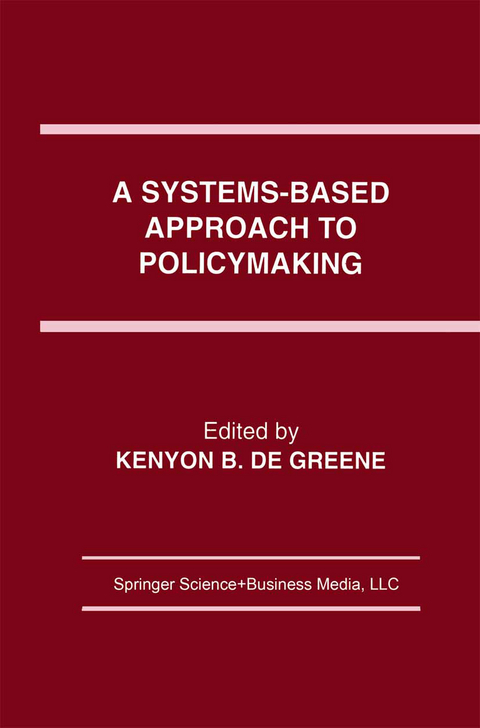
A Systems-Based Approach to Policymaking
Springer-Verlag New York Inc.
978-1-4613-6417-7 (ISBN)
1. Policy Challenges in a World of Nonlinearity and Structural Change.- and Main Assumptions and Problem Sets.- New Thinking for New Times.- What is Policymaking?.- Cognitive/Emotional Models of Policymakers and Decisionmakers.- A Simple Mathematical Model of Nonlinearity.- Structural Change the Kondratiev and Hegemonic Cycles/Structures and the Life Cycle of the Present Stage of World.- Civilization.- Let the Policy Fit the Time.- Conclusions and Recommendations—Policy Guidance.- References.- 2. Policy in a World of Evolution, Learning, and Ignorance.- The Mechanical and Organic Open-Systems Paradigms Further Contrasted.- Evolutionary Drive.- Applications for Policy Exploration: From Settlement To Finance.- Discussion.- References.- 3. Adaptive Control and Conflict Resolution for International Stability.- Overview of International Stability and Conflict Resolution Issues.- The Peace/War/Peace Process and Some of its Elements.- International Stability and Peace.- Nation Block Diagrams.- Peace/War/Peace Time (Activity) Cycle.- Normal, Alert, or Emergency Conditions of International Policymaking and Decision-Making.- Adaptive Control Features for International Relationships.- Basic Assumptions about the International System and Conflict.- Elements of Conflict Resolution.- Potential Areas for International Conflict.- Progress Toward International Stability and Peace.- Common Security Objectives.- Influence of the Past, Present, and Future on National Attitudes.- Decrease the Likelihood of War, Increase the Likelihood of Peace.- What is to be Done Now?.- Conclusions.- References.- 4. Field-Theoretic Framework for Systems Theory and Systems Thinking.- The Nature and History of Field Theory Applied to Nonliving and Living Systems.- Alternative or Complementary Perspectiveson.- Field Theory and on World Systems.- Synopsis and Interfacing of Current Systems Theories.- Field-Theoretic Principles.- Faith, Ideology, Science, and Religion.- The Acceptance of New Paradigms.- Guided Structural Change in the World System Field.- Final Remarks.- References.- 5. School for Rulers.- Contemplating the Taboo: Rulers Must Learn.- Premises and Thesis.- Ideological and Structural Hurdles.- Design of a School For Rulers.- Back to Reality: Practical Recommendations.- Epilogue.- References.- 6. Policy: Appearance and Reality.- Introduction: Overview of “Problems” and “Solutions”.- Concepts and Definitions of Policy.- Distinctive Problems of Policy Formulation.- A Systems-Theoretic Interpretation.- Four World Hypotheses.- Limitations of Formism and Formal Rational Models.- Policy Expertise, and Rationality Revisited.- Challenges and Recommendations.- References.- 7. System Dynamics and the Lessons of 35 Years.- Designing Managerial and Social Systems.- A New Education for Corporate and Government Leaders.- Modeling for What Purpose?.- The System Dynamics Paradigm.- Learning From Models.- A New Basis for Pre-College Education.- References.- 8. Whole-System Concepts in Societal Transformation.- Signs of A Fundamental Transformation.- Policies for Whole-System Transformation.- Concluding Observations.- References and Suggested Reading.- 9. Breaking out of the Systems Quandary.- The Systems Quandary.- Breaking Out.- Final Words.- References.- 10. Decision Management, Then and Now, 1790, 1890, and 1990: Selected Scenario Models.- Some Definitions and Limitations.- A Basic Decision-And-Command Management Model.- Two Brief Scenario Models.- Decisionmaking in the Gulf Crisis/War: Events of 1990–1991.- Significance of the Gulf Episode.- Conclusions.-References.
| Zusatzinfo | XIX, 355 p. |
|---|---|
| Verlagsort | New York, NY |
| Sprache | englisch |
| Maße | 155 x 235 mm |
| Themenwelt | Informatik ► Grafik / Design ► Digitale Bildverarbeitung |
| Informatik ► Theorie / Studium ► Künstliche Intelligenz / Robotik | |
| Mathematik / Informatik ► Mathematik | |
| Wirtschaft ► Betriebswirtschaft / Management | |
| Wirtschaft ► Volkswirtschaftslehre ► Wirtschaftspolitik | |
| ISBN-10 | 1-4613-6417-5 / 1461364175 |
| ISBN-13 | 978-1-4613-6417-7 / 9781461364177 |
| Zustand | Neuware |
| Informationen gemäß Produktsicherheitsverordnung (GPSR) | |
| Haben Sie eine Frage zum Produkt? |
aus dem Bereich


